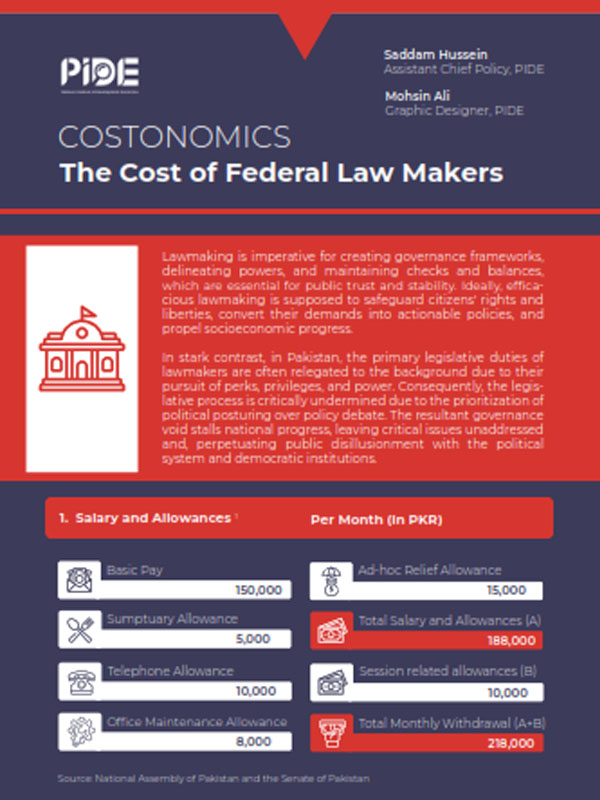
Pakistan Institute of Development Economics
- Home
Our Portals
MenuMenuMenuMenuMenuMenuMenu - ResearchMenuMenuMenuMenuMenuMenuMenu
- Discourse
- The PDR
- Our Researchers
- Academics
- Degree Verification
- Thesis Portal
- Our Portals
The Cost Of Federal Law Makers
Lawmaking is imperative for creating governance frameworks, delineating powers, and maintaining checks and balances, which are essential for public trust and stability. Ideally, efficacious lawmaking is supposed to safeguard citizens’ rights and liberties, convert their demands into actionable policies, and propel socioeconomic progress.
In stark contrast, in Pakistan, the primary legislative duties of lawmakers are often relegated to the background due to their pursuit of perks, privileges, and power. Consequently, the legislative process is critically undermined due to the prioritization of political posturing over policy debate. The resultant governance void stalls national progress, leaving critical issues unaddressed and, perpetuating public disillusionment with the political system and democratic institutions.
- Salary and Allowances[1]
| Per Month (in PKR) | |
| Basic Pay | 150,000 |
| Sumptuary Allowance | 5,000 |
| Telephone Allowance | 10,000 |
| Office Maintenance Allowance | 8,000 |
| Ad-hoc Relief Allowance | 15,000 |
| Total Salary and Allowances (A) | 188,000 |
| Session related allowances (B) | 30,000 |
| Total Monthly Withdrawal (A+B) | 218,000 |
Source: National Assembly of Pakistan and the Senate of Pakistan
- Office and Residence
- Every MNA and Senator, is provided accommodation in parliament lodges, in Islamabad’s red zone and an office space.
- Minimum rental value of parliament lodge: PKR 1 million/month
- Office space: valued at PKR 0.2 million/month.
- Parliamentary Session Arrangements
- The cost of holding parliament sessions is substantial:
- Each sitting incurs: PKR 66.5 million[2] on average
- Travel Expenses
- Legislators receive substantial travel allowances:
- Air Travel: 25 business class return tickets/year
- Road Travel: PKR 90,000/year annually
- Development Funds
- Development funds meant to be managed by local governments, are often funneled through legislators, with each legislator receiving a significant amount:
- From PKR 20 million to PKR 30 million/year,
- averaging PKR 2 million/month.
- Development funds meant to be managed by local governments, are often funneled through legislators, with each legislator receiving a significant amount:
- Total Cost
- Cost of Pakistan’s federal legislators: PKR 27.67 billion/year.
- Breakdown:
- An MNA costs: PKR 717,258.52,
- A Senator costs: PKR 1,136,176.66.
- On average: PKR 813,340.66 per lawmaker/day, however, considering National Assembly and Senate work 88 and 57 days a year, respectively.
- Factoring average attendance of just 63%: ⬆️ daily cost/lawmaker: PKR 1,292,997.66.
- Breakdown:
| Cost[3] | National Assembly (PKR) | Senate (PKR) |
| Legislators and Employees Related Expenses (Pay and Allowances)[4] | 5579571000 | 3159052000 |
| Operational Expenses | 2062929000 | 1437979000 |
| Employees Retirement Benefits | 51600000 | 39074000 |
| Grants, Subsidies and Write-off Loans | 378300000 | 200852000 |
| Physical Assets | 85800000 | 147050000 |
| Repairs and Maintenance | 147300000 | 52200000 |
| Residence and Office Opportunity Cost[5] | 4838400000 | 1440000000 |
| Development Funds[6] | 8064000000 | – |
| Total | 21207900000 | 6476207000 |
| Total in Billions | 21.20 billion | 6.47 billion |
| Dividing Total by average number of sittings per year (NA=88, Senate=57)[7] | 240.99 million | 113.61 million |
| Dividing by number of parliamentarians | 717258.52 | 1136176.66 |
| Calculating Average Cost per Lawmaker per day[8] | = (Average Cost per MNA x MNAs) + (Average Cost per Senator x Senators)/ (MNAs + Senators) | |
| Cost per Lawmaker per day | PKR 813,340.66 | |
| Factoring in the Attendance[9] | PKR 1292997.66 | |
- Conclusion
- The analysis about the cost of federal legislators in Pakistan underscores the importance of accountability and productivity in the legislative process. While the financial compensation of lawmakers is crucial for their effective functioning, it must be justified through diligent legislative activity and tangible benefits to society. Ensuring that public funds are utilized efficiently to support a legislative framework that promotes development, justice, and good governance is essential for maintaining public trust and enhancing democratic governance. However, we see that the situation is quite in contrast.
[1] Along with salaries and benefits, federal legislators entitled to various allowances to cover daily expenses
[2] Encompasses various operational expenses necessary to facilitate smooth functioning of both houses of parliament.
[3] This estimate is conservative. Costs could soar if we include session security (excluding internal Parliament security), and lawmakers using influence for job placements, with poor lawmaking further increasing the overall expense.
[4] Includes only salaries and allowances for lawmakers, and salaries, allowances and retirement benefits for their staff
[5] The figures are taken from Pink Book for the year 2023-24
[6] Author’s calculations
[7] PILDAT
[8] per day refers specifically to a day of active legislative functioning
[9] Average attendance for both houses in around 63%, so the effective time of parliamentary functioning will be slashed by 37%, with the revised number of days of NA being 56 and that of the Senate being 35.



